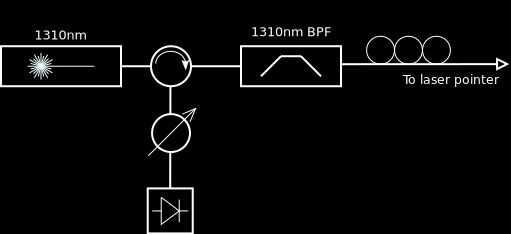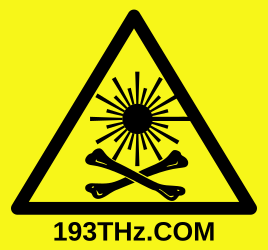

August 2024
Recently, inexpensive yellow laser pointers have appeared on the market. No laser diodes are available in this wavelength region, so I naturally became curious about what is inside and immediately clicked the "Buy now" button on Aliexpress to find out.
It turns out that they are DPSS lasers whose construction is very similar to the common "second generation" 532nm laser pointers described in Sam's Laser FAQ, with a diode-pumped microchip (DPM). No information could be located about yellow DPMs, but my theory is that they are Nd:YVO4 lasers running simultaneously at 1064nm and 1342nm, with an intracavity nonlinear crystal to produce the sum frequency at 593nm.
Since 1342nm is right there in the telecom band where laser optics actually work and don't cost as much as a Lamborghini, I came up with the idea of replacing that laser line with light injected by an external CWDM diode. It could enable those cheap pointers to access a wide range of unusual laser wavelengths - among which the 585nm transition of Ba+ is of particular interest.
When it comes to coupling DPMs to single-mode telecom fiber, Murphy seems to have taken a day off as the output of the bare DPM appears to be very well matched to the inexpensive fiber-fused collimators that are normally used inside components such as WDM filters, variable attenuators, and AOMs. They are available under $10, including fiber connector, from various suppliers such as Box Optronics. In addition to their low cost and their fortunate compatibility with DPMs, they possess a key advantage over other types of fiber collimators which is their excellent return loss. This high return loss substantially helps eliminate unwanted etalon fringes in the system: we'll want to look at the response of the DPM's cavity and not at parasitic interferometers that may have been formed.
Open the laser pointer module and remove all the optics after the DPM. Besides the obvious, there typically will be a plastic lens glued right in front of the DPM, which easily comes off with a pair of pliers.
A word of caution: this exposes the high-power 808nm pump light which represents a serious vision hazard, so you must wear suitable laser safety glasses. The 1064nm and 1342nm outputs and the injection laser are NOT eye-safe either, so the glasses will have to block these too. High-quality glasses, with good design that is comfortable to wear even on top of prescription glasses, can be purchased from Univet.
You'll only want a few centimeters of total beam path between the DPM and the fiber collimator, so install the laser pointer module on a kinematic mount (which can double as heatsink - add some thermal paste so the pointer can run indefinitely, otherwise it overheats after a few minutes) and use just one mirror on another kinematic mount to steer the beam into the collimator. This provides the required four degrees of freedom for the alignment, with a short beam path.
The alignment is quite easy with a two-step process. Turn on the laser pointer and connect a VFL on the other end of the fiber with the collimator. Adjust the four screws until all the laser dots that you see on the mirror and the DPM's surface are aligned. This provides a rough alignment which should be enough to couple at least a few hundred microwatts of IR light into the telecom fiber, which is easily measurable. The second step is to disconnect the VFL and replace it with a telecom power meter. Then adjust the four screws in turn, each time maximizing the reading on the power meter. After a few rounds of this, the optical power into the fiber will have greatly increased - I have obtained a reading of 27mW with a power meter set to 1310nm. This is of course an imprecise measurement as the power meter is not receiving 1310nm light but instead a mix of 1064nm and 1342nm in unknown proportions.
Once this alignment is done, it becomes straightforward to scan a common 1310nm telecom DFB laser and observe the resonance peaks of the pointer's Fabry-Perot cavity, using the setup below:

The trick is that the laser pointer needs to be turned on for the cavity to resonate properly - at first sight, it may seem that the DPM forms a plane-plane mirror cavity, but in reality this may not be quite the case as some thermal lensing is likely taking place inside. This is the reason for the presence of the 1310nm filter (a common and low-cost CWDM model), whose purpose is to suppress the 1064nm/1342nm light which would otherwise drown the signal and/or cause problems with the DFB (circulators only work over a narrow bandwidth).
To efficiently and more easily see the wavelength that we want, we need to suppress lasing on the 1342nm line. This is quite easy to do since it has a substantially higher laser threshold than the 1064nm line, so reducing the 808nm pump power does the job. This can be done by a number of methods depending on your pointer: using the adjustment pot on the driver that the pointer came with, undervolting the driver, or removing it and driving the pump diode directly. You'll want to go just below the 1342nm threshold so as to maximize the 1064nm power available for frequency conversion. Interestingly, when the pointer is operated in this regime, a faint 532nm emission is visible, despite the poor phase-matching conditions in the nonlinear crystal.
An alternative technique, which can potentially produce higher output power at the expense of more complexity, instability, and difficult alignment, is to reflect the 1064nm light using a narrowband dielectric mirror, making a kind of "external cavity DPM". Since both the 1342nm and the 1064nm lines compete for the same upper laser level, reducing the losses at 1064nm substantially increases the laser threshold for the 1342nm line, and the pointer outputs 532nm even when operated at nominal pump levels. 1064nm is a very common laser wavelength, and inexpensive mass-produced mirrors of very good quality are available from several Chinese suppliers - at least flat mirrors, which may or may not be suitable for long-term stable operation. This technique is demonstrated in this video. I was not able to keep the laser stable for more than a few dozen seconds using this technique, so the rest of the experiment was performed by lowering the pump power instead. If you want to try this second technique, it may help to temperature-stabilize the DPM and use higher-quality mounts (for example, Oeabt produces good knockoffs of expensive U.S. optomechanics).
Once the pointer is operating on 1064nm only, and after some fiddling with the polarization controller, scanning the 1310nm laser again causes the pointer to emit very visible flashes of 587nm light, coincident with absorption peaks on the IR photodetector, as it crosses into the DPM cavity resonances. I was using a 20mW Box Optronics diode operated at 19mW, linewidth about 10MHz, and 13mW of light was available before the collimator, after the various losses in the optical components and fiber connectors.
To turn this proof-of-concept into a usable CW laser, it should be straightforward to lock the DFB laser and the cavity using the Pound-Drever-Hall technique. The yellow output beam can be extracted, without losing too much of the injection light, using a dielectric mirror for visible light with the backside polished, since those are usually transparent in the infrared. The detailed spectrum of the 1064nm light inside the DPM would also need to be characterized and controlled.
Without knowing the phase matching bandwidth of the nonlinear crystal nor the DPM mirror reflectivity's dependence on wavelength, it is hard to tell what wavelength range could be reached with such a laser design. In the best case, which is probably too optimistic, the entire telecom band 1270-1610nm could be converted with at least some output power, which would cover the 578-640nm region. It is more likely that the shorter wavelengths could be reached, which are the most interesting since diodes become available at the other end.
It would be interesting to see if the low-cost Osram PL530 OPSL can be hacked in a similar way, perhaps by operating its nonlinear element outside the specified temperature range so as to obtain phase matching at the target wavelength. The main advantage over the laser pointers is the cavity of the PL530 is designed for single-frequency operation with a clean spatial profile.
Comment from Erik Streed: "Would be of interest to NV-/NV0 colour centre changing in diamond which isn't very frequency sensitive like an ion or atom would be."